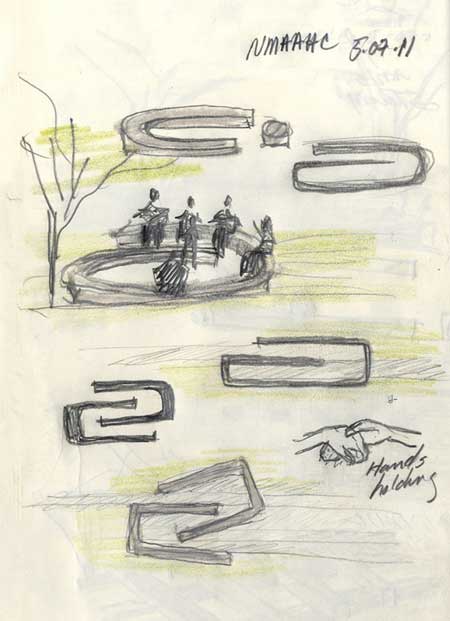New Museum Brings Hope of African Americans to the National Mall

The National Museum of African American History and Culture is a breathtaking new presence on the National Mall. Found just northeast of the Washington Monument, the museum, which opens September 24, makes accessible the almost-unimaginable journey of African Americans over the past few centuries: from the horrors of slavery, to the long fight for equality, and, finally, transcendence through spirituality, and extraordinary cultural and artistic achievements.
Over 100 years in the making, the museum cost $540 million, with half of those funds raised from over 100,000 contributors. And some 40,000 Americans contributed works that will be included in the museum’s permanent collection, explained museum director Lonnie G. Bunch III at the media preview.
The museum opens at an opportune time, when race relations are at a new low. As Bunch said, “race and cultural differences now dominate the national discourse. Racism is not a thing of the past. But we believe this museum can be a place that brings people together. This museum can help advance the conversation and be a beacon of what America can be.”
The building itself makes a richly symbolic statement. Lead designer David Adjaye and lead architect Philip Freelon, together with their architectural team Freelon Adjaye Bond/SmithGroup, created a dramatic 200-feet-by-200-feet box, topped with a corona inspired by the “three-tiered crowns used in Yoruba art from West Africa,” where many African American slaves came from. The corona is covered in an “ornamental bronze-colored metal lattice” inspired by the ironwork created by American slaves for estates in New Orleans, Charleston, and other Southern cities.
The building is well-served by a thoughtful and somewhat understated landscape by Gustafson Guthrie Nichol (GGN). Designed by Kathryn Gustafson, FASLA, and Rodrigo Abela, ASLA, the landscape treats the building as a pavilion in the broader landscape of the National Mall and aims for maximum circulation.
Walking the site with Abela, he explained how visitors can find African American themes of “resilience, spirituality, and hope” symbolically represented in the landscape. On the north side, visitors enter off Constitution Avenue, where they will see a black granite wall that provides the visual base of the site and doubles as a secure barrier. The granite wall is thick here — about 6-feet-wide — and is black to represent the canal water that once flowed through the site. Another possible interpretation of the material: African Americans’ labor is the foundation upon which was built the National Mall. Abela explained how Rugo Stone highly polished the edge of the granite so that it glimmers in the light, creating a horizon that underlines the building.

As you walk up the paths on the north side, you will find they are like arms extending out in an embrace. Where the arms meet in a central point, Abela highlighted, is the place where visitors can either decide to veer right and head to the Washington Monument, or veer left and enter the building’s north entrance.

Within this embrace, there’s an oculus, which shines a shaft of light into a “contemplative court” set in subterranean galleries that delve into the darkest times of slavery. “It’s a lantern, a welcoming and safe place.” As such, the landscape gently leads you up to the oculus on the surface.


And near the embrace, there is a symbolic reading grove, a place where a group of school kids or a few families could gather and talk about the experience about the museum. GGN designed this grove to mimic the “brush arbors,” the community gathering places, many early slave and African American communities would create, even before they had built a church.


Walking along the western edge of the building, there is a lawn and rows of trees, which are reflected in the building’s wall of windows. Abela said over 100 trees were planted, including elms, oaks, beeches, magnolias, gingkos, sassafras, and cherry trees. “The Smithsonian wanted as much diversity as possible.” In coming decades, those trees will grow to enshroud the building, softening its boldness. And throughout the lawns, some 400,000 crocuses were planted. One of the first plants to bloom, they represent hope for the future.


On the eastern edge of the building, there is a staircase leading down to the lower level, which is an emergency exit for the auditorium, a separate entry into a loading dock, and bicycle parking for staff.
The southern entrance of the park, right off the National Mall, is where the Smithsonian expects about 70 percent of visitors will enter. There is a grand porch, another reference to African American culture, with a striking overhang providing shade over a fountain, which wasn’t working for the media preview, but will bring another cooling aspect during D.C.’s sweltering summers.


Multiple paths invite visitors in from Madison Avenue. Once they pass through the gates, there is a sense of passing through a threshold into a new environment.

The southern edge of the park is richer with small plants and shrubs, which form a rain garden that mute the effect of the stark black granite walls.


A note on sustainability: More than half of the LEED Gold building is buried below ground, which means lower energy use. And below the structure, there are two large cisterns that collect rainwater that hits the building, so that it can be reused for irrigation.
Through the landscape architecture, Abela explained, “the story of African Americans are made part of the national story,” as represented by the expansive National Mall. “It’s a site that’s connected to the greater landscape beyond.”
Posted by “The Dirt”
https://dirt.asla.org/2016/09/16/new-museum-brings-hope-of-african-americans-to-the-national-mall/

